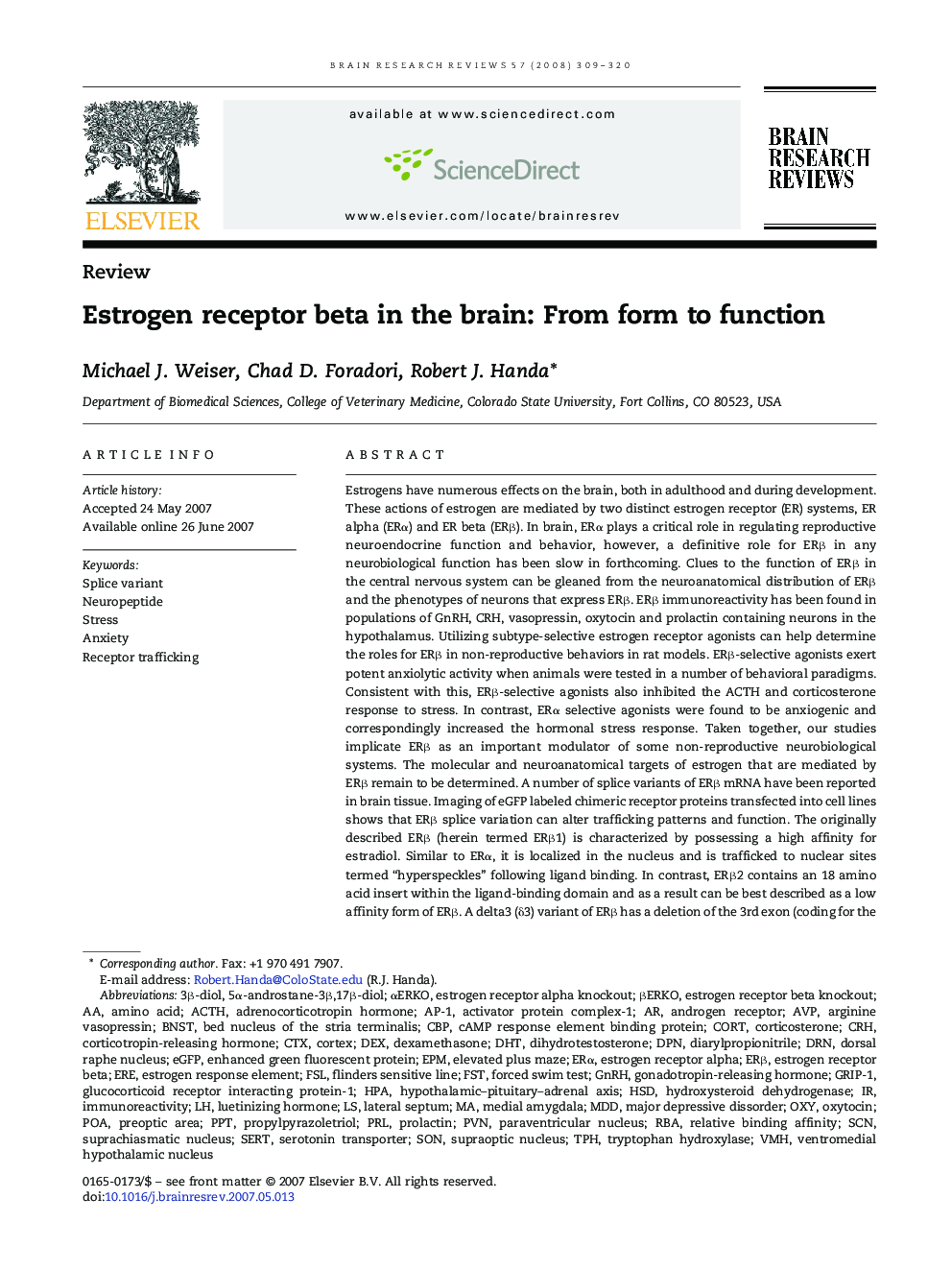| کد مقاله | کد نشریه | سال انتشار | مقاله انگلیسی | نسخه تمام متن |
|---|---|---|---|---|
| 4333830 | 1294755 | 2008 | 12 صفحه PDF | دانلود رایگان |
عنوان انگلیسی مقاله ISI
Estrogen receptor beta in the brain: From form to function
دانلود مقاله + سفارش ترجمه
دانلود مقاله ISI انگلیسی
رایگان برای ایرانیان
کلمات کلیدی
ERβFSTAP-1DRNAVPPRLBNSTCBPTphERαDPNFSLSCNCTXVMHDiarylpropionitrileACTHGnRHGRIP-1RBADHTDEXCRHPOAPPTEREeGFPEPMMDDHSD3β-diol - 3 بتا دیول5α-androstane-3β,17β-diol - 5α-آندروستان-3β، 17 بتا دیولforced swim test - آزمون شناور اجباریmedial amygdala - آمدیگدال medialamino acid - آمینو اسیدStress - استرس یا فشار روانیAnxiety - اضطرابOXY - اکسیoxytocin - اکسیتوسینImmunoreactivity - ایمنی فعالelevated plus maze - بالا به همراه پیچ و خمDexamethasone - دگزامتازونDihydrotestosterone - دی هیدروتستوسترونSERT - سختserotonin transporter - سروتونین حمل کنندهlateral septum - سپتوم جانبیestrogen response element - عنصر پاسخ استروژنSON - فرزند پسرFlinders sensitive line - فلیندرز حساس خطReceptor trafficking - قاچاق گیرندهCortex - قشرPVN - مالیات بر ارزش افزودهhypothalamic–pituitary–adrenal axis - محور هیپوتالاموس-هیپوفیز-آدرنالPreoptic area - منطقه PreopticHPA - میلی بار یا هکتوپاسکالNeuropeptide - نوروپپتیدsplice variant - نوع اتصالاتSupraoptic nucleus - هسته Supraopticbed nucleus of the stria terminalis - هسته تخت ترمینال های استریdorsal raphe nucleus - هسته رافهVentromedial hypothalamic nucleus - هسته هیپوتالاموس Ventromedialparaventricular nucleus - هسته پروژسترویکSuprachiasmatic nucleus - هستههای سوپراکیاسماتیکadrenocorticotropin hormone - هورمون adrenocorticotropincorticotropin-releasing hormone - هورمون آزاد کننده کورتیکوتروپینGonadotropin-releasing hormone - هورمون آزاد کننده گنادوتروپینhydroxysteroid dehydrogenase - هیدروکسیستروئید دهیدروژنازtryptophan hydroxylase - هیدروکسیلاز تریپتوفانRelative binding affinity - وابستگی نسبیarginine vasopressin - وازوپرسین آرژینینcAMP response element binding protein - پروتئین اتصال دهنده عنصر پاسخ cAMPenhanced green fluorescent protein - پروتئین فلورسنت سبز افزایش یافته استProlactin - پرولاکتین CORT - کورتCorticosterone - کورتیکوسترونAndrogen Receptor - گیرنده آندروژنیEstrogen receptor alpha - گیرنده استروژن آلفاEstrogen receptor beta - گیرنده استروژن بتا
موضوعات مرتبط
علوم زیستی و بیوفناوری
علم عصب شناسی
علوم اعصاب (عمومی)
پیش نمایش صفحه اول مقاله

چکیده انگلیسی
Estrogens have numerous effects on the brain, both in adulthood and during development. These actions of estrogen are mediated by two distinct estrogen receptor (ER) systems, ER alpha (ERα) and ER beta (ERβ). In brain, ERα plays a critical role in regulating reproductive neuroendocrine function and behavior, however, a definitive role for ERβ in any neurobiological function has been slow in forthcoming. Clues to the function of ERβ in the central nervous system can be gleaned from the neuroanatomical distribution of ERβ and the phenotypes of neurons that express ERβ. ERβ immunoreactivity has been found in populations of GnRH, CRH, vasopressin, oxytocin and prolactin containing neurons in the hypothalamus. Utilizing subtype-selective estrogen receptor agonists can help determine the roles for ERβ in non-reproductive behaviors in rat models. ERβ-selective agonists exert potent anxiolytic activity when animals were tested in a number of behavioral paradigms. Consistent with this, ERβ-selective agonists also inhibited the ACTH and corticosterone response to stress. In contrast, ERα selective agonists were found to be anxiogenic and correspondingly increased the hormonal stress response. Taken together, our studies implicate ERβ as an important modulator of some non-reproductive neurobiological systems. The molecular and neuroanatomical targets of estrogen that are mediated by ERβ remain to be determined. A number of splice variants of ERβ mRNA have been reported in brain tissue. Imaging of eGFP labeled chimeric receptor proteins transfected into cell lines shows that ERβ splice variation can alter trafficking patterns and function. The originally described ERβ (herein termed ERβ1) is characterized by possessing a high affinity for estradiol. Similar to ERα, it is localized in the nucleus and is trafficked to nuclear sites termed “hyperspeckles” following ligand binding. In contrast, ERβ2 contains an 18 amino acid insert within the ligand-binding domain and as a result can be best described as a low affinity form of ERβ. A delta3 (δ3) variant of ERβ has a deletion of the 3rd exon (coding for the second half of the DNA-binding domain) and as a result does not bind an estrogen response element in DNA. δ3 variants are trafficked to a unique low abundance and larger nuclear site following ligand binding. A delta4 (δ4) variant lacks exon 4 and as a result is localized to the cytoplasm. The amount of individual splice variant mRNAs varies depending upon brain region. Examination of neuropeptide promoter regulation by ERβ splice variants demonstrates that ERβ functions as a constitutively active transcription factor. Moreover, it appears that splice variation of ERβ alters its ability to regulate transcription in a promoter-dependent and ligand-dependent fashion.
ناشر
Database: Elsevier - ScienceDirect (ساینس دایرکت)
Journal: Brain Research Reviews - Volume 57, Issue 2, 14 March 2008, Pages 309-320
Journal: Brain Research Reviews - Volume 57, Issue 2, 14 March 2008, Pages 309-320
نویسندگان
Michael J. Weiser, Chad D. Foradori, Robert J. Handa,